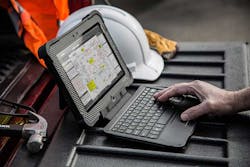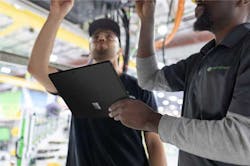Clean Slate: Choosing the Right Mobile Computer for 2019
In 2019, there will be 8.3 billion actively connected Internet of Things devices, surpassing the number of people on the planet, according to recent IoT Analytics data. That's an almost inconceivable amount of M2M communication—and data—that human workers are going to have to make sense of. This data arrives in real-time and from just about anywhere on the map, so plant decision-makers need a powerful, reliable, and most importantly, mobile interface at the ready 24/7.
"Everybody is on the move now, doing work wherever you are, so you want something flexible," says Marco Nielsen, VP of Managed Mobility Services at Stratix.
Nielsen notes that more and more managers on the factory floor are turning to tablets and 2-in-1 computers, as opposed to laptops, to visualize equipment performance, production status, and all the other KPIs your business needs to ensure profitability.
Another important factor is that while batteries themselves have not greatly advanced, manufacturers have found ways to reduce how much energy the CPU and apps use, so these devices will spend more time on the floor, and not charging in your office.
And this year manufacturers were gifted three great new mobile solutions from which to choose: the Zebra Technologies XBOOK B10, the Microsoft Surface Pro 6, and most recently, the iPad Pro.
Nielsen's pick is the Surface Pro 6, as his Surface 3 has served him well on plane trips. No two factories are alike, though, so there's not one clear-cut best choice. Here are some vital stats to help you choose the right solution for you.
XBOOK B10 2-in-1 Tablet PC (128 GB SSD): $2,975
(XBOOK B10 was discontinued September 30, 2020. Zebra recommends the XPAD L10 as a replacement)If you think you have to sacrifice performance for durability when using a rugged computer, you haven’t used the XBOOK B10. At 2.4 pounds, it's a little heavier than the others listed here, and the 10.1-inch screen is smaller but makes up for it in downright toughness.
On the inside, like the Surface Pro 6, it has an Intel Core i5 processor and runs Windows 10 Pro. The difference is that this versatile 2-in-1 has a casing stronger than steel (magnesium alloy) and can survive a 5-foot drop, and Weather is not a problem either, as it holds up in temperatures down to -34°C.
And it's easier to hold, thanks to a rotating ergonomic Velcro strap on the back. Additional features include a spill-resistant keyboard and touchscreen still visible in direct sunlight that can be operated with gloves. The ports are sealed against the elements as well, just in case it's caught in a storm or possibly a washdown.
Check out our full review of the XBOOK B10 HERE
If you wear a tie more often than not, a consumer model might be more your speed. But if you live in the manufacturing trenches, you'll want this by your side. And if price is a limiting factor, the total cost of ownership is much less than a conventional $600 iPad.
"The total cost of ownership ends up being about half," notes Tom Kost, Zebra Technologies Sr. Product Manager.
Surface Pro 6 (128 GB SSD) $775
This popular 2-in-1 tablet has a 12.3-inch screen, 8 GB memory, an Intel Core i5 processor, and is packaged in a slim, 1.7-pound form factor.
Users don’t have to sacrifice power making the switch from a bulkier laptop, though. A 1-TB version is also available.
"It has a full-blown operating system, designed to be used by fingers," says Nielsen, so users don’t lose out if they switch from a bigger laptop running Windows. It also has the added benefit of a touchscreen to make accessing Office 365 all the easier.
Microsoft says the battery can play 13.5 hours of video before running out, so it should have plenty of life even on those shifts that seem like they will never end.
Durability must also be considered in industrial settings, and the Surface Pro 6 performs surprisingly well for such a thin device.
One "snap" test by YouTube tester Zack Nelson of Jerry Rig Everything, where he pulled firmly down on both ends, showed that the tablet may bend, but won’t break. A similar test of the iPad Pro proved that the ultra-thin Apple offering "folded like a piece of paper."
"It's pretty safe to say that the Surface Pro 6 can handle quite a bit more abuse than the iPad Pro," Nelson concludes.
That's not to say the Surface should be expected to survive harsh environments. Adding on a protective casing, which starts at around $50, would be a wise investment.
iPad Pro (11 in., 128 GB) $799
Apple's iPad Pro 11 takes the best features of the latest iPhones and adds a powerful A12X Bionic processor to create a serious rival to the Surface—as long as you don’t need to run Windows.
It's lighter, at 1.4 pounds, and can work as a 2-in-1 tablet with the Smart Keyboard Folio ($179). You can also upgrade to a 12.9-inch, 1-TB version for $1,749.
The LTE connectivity provides the biggest advantage, untethering a plant manager from WiFi and allowing them to access ERP or other systems data anywhere their cell coverage allows: at home, in the airport or their favorite mom and pop diner.
If everyone involved has iOS 12.1, Group FaceTime can be an excellent way to quickly video conference with the team (up to 32 members) to discuss integration plans or just to check-in. Users who have an older version than iPhone 6 or the early model iPad could still join by audio.
If battery life is a sticking point, the iPad Pro has the biggest advantage. Laptop Magazine logged the iPad Pro (12.9-inch) at 13:14 hours of web-surfing on one charge, while the Surface Pro 6 lasted 9:20 hours, or 29% less.
About the Author
John Hitch
Editor, Fleet Maintenance
John Hitch, based out of Cleveland, Ohio, is the editor of Fleet Maintenance, a B2B magazine that addresses the service needs for all commercial vehicle makes and models (Classes 1-8), ranging from shop management strategies to the latest tools to enhance uptime.
He previously wrote about equipment and fleet operations and management for FleetOwner, and prior to that, manufacturing and advanced technology for IndustryWeek and New Equipment Digest. He is an award-winning journalist and former sonar technician aboard a nuclear-powered submarine where he served honorably aboard the fast-attack submarine USS Oklahoma City (SSN-723).



